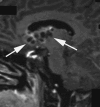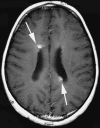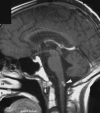Pattern of relapse and outcome of non-metastatic germinoma patients treated with chemotherapy and limited field radiation: the SFOP experience
- PMID: 20716594
- PMCID: PMC3018943
- DOI: 10.1093/neuonc/noq093
Pattern of relapse and outcome of non-metastatic germinoma patients treated with chemotherapy and limited field radiation: the SFOP experience
Abstract
Over the last two decades, chemotherapy has been introduced in protocols for patients with intracranial germinoma with the objective of reducing the volume and the dose of irradiation without compromising survival rates. The aim of this work is to critically analyze the pattern of relapse in a cohort of patients with nonmetastatic germinoma prospectively treated with chemotherapy followed by focal field radiation. Data of all germinoma patients registered in the French protocol for intracranial germ cell tumors between 1990 and 1999 were reviewed. The pattern of relapse, management, and outcome were analyzed in 10 of 60 patients who developed a recurrence after initial treatment. In 9 patients, the site of recurrence was local or loco-regional, notably in the periventricular area for 8. One patient only had isolated distant leptomeningeal relapse. The review of the sites of relapse suggests that most recurrences could have been avoided with a larger ventricular field of radiation. Treatment at first relapse included chemotherapy (10 patients), high-dose chemotherapy and stem cell transplant (8 patients), and/or radiation therapy (4 patients). Five patients experienced a second relapse. At a median follow-up of 72 months since the first relapse, 8 patients are alive in second or third remission. This review identified an excess of periventricular relapses when the focal field of radiation is used in the combined management of germinoma. These relapses are predominantly marginal or outside radiation fields. Ventricular field radiation appears a logical alternative to decrease the incidence of such relapses. Future trials should aim at better identifying patients who may benefit from local and ventricular radiation, respectively.
Figures






References
-
- Dearnaley DP, A'Hern RP, Whittaker S, Bloom HJ. Pineal and CNS germ cell tumors: Royal Marsden Hospital experience 1962–1987. Int J Radiat Oncol Biol Phys. 1990;18(4):773–781. - PubMed
-
- Merchant TE, Sherwood SH, Mulhern RK, et al. CNS germinoma: disease control and long-term functional outcome for 12 children treated with craniospinal irradiation. Int J Radiat Oncol Biol Phys. 2000;46(5):1171–1176. - PubMed
-
- Bamberg M, Kortmann RD, Calaminus G, et al. Radiation therapy for intracranial germinoma: results of the German cooperative prospective trials MAKEI 83/86/89. J Clin Oncol. 1999;17(8):2585–2592. - PubMed
-
- Matsutani M. Combined chemotherapy and radiation therapy for CNS germ cell tumors—the Japanese experience. J Neurooncol. 2001;54(3):311–316. - PubMed
-
- Robertson PL, DaRosso RC, Allen JC. Improved prognosis of intracranial non-germinoma germ cell tumors with multimodality therapy. J Neurooncol. 1997;32(1):71–80. - PubMed
Publication types
MeSH terms
Substances
LinkOut - more resources
Full Text Sources
Medical

